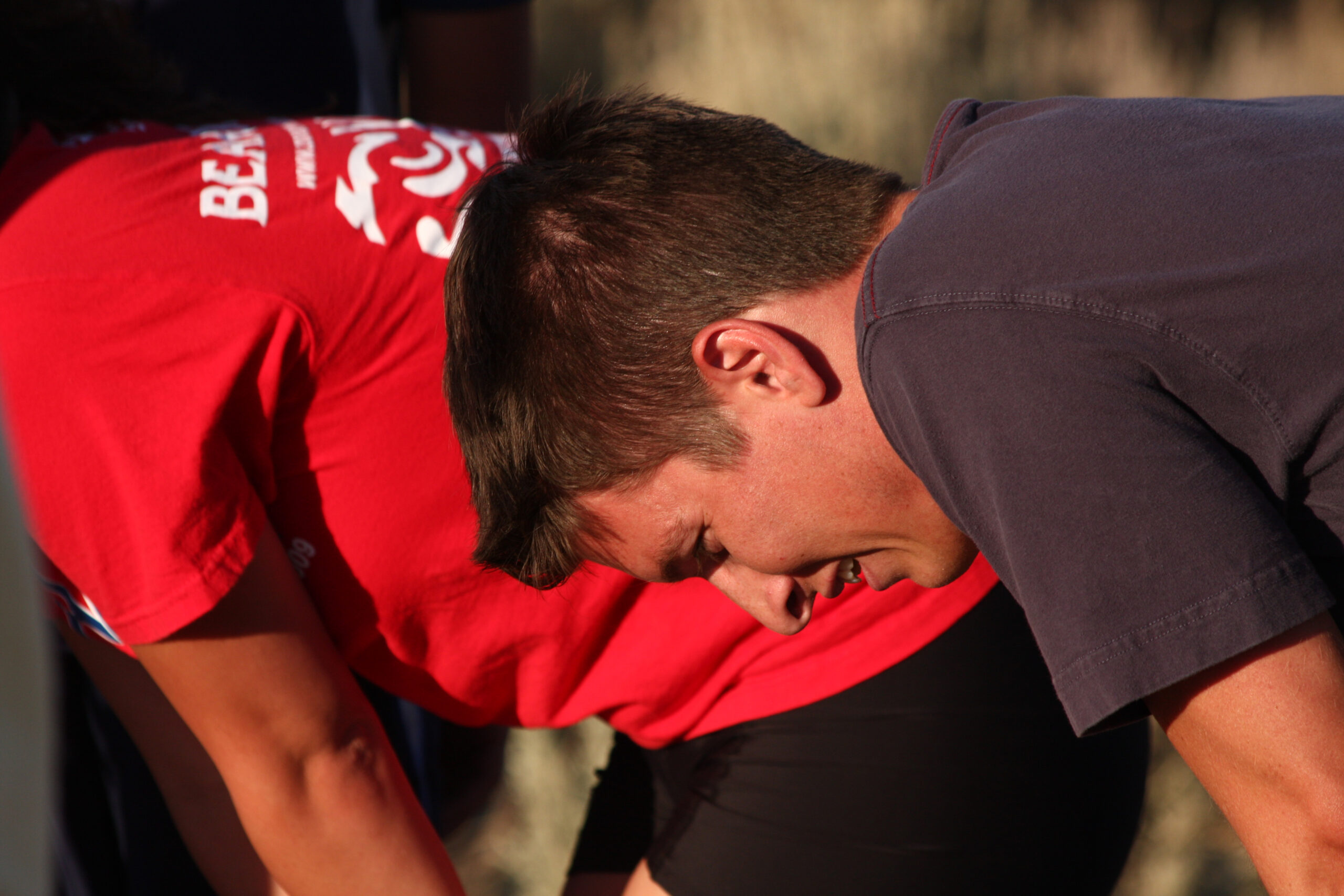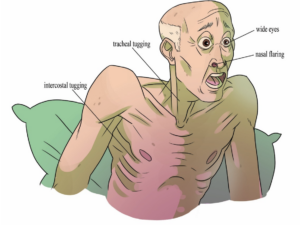9.8 Respiration
What Is Respiration?
Respiration refers to a person’s breathing and the movement of air into and out of the lungs. The respiratory system provides oxygen to body tissues for cellular respiration, removes the waste product carbon dioxide, and helps maintain acid–base balance. Inspiration is the process that causes air to enter the lungs, and expiration is the process that causes air to leave the lungs. A respiratory cycle (or one breath while you are measuring respiratory rate) is one sequence of inspiration and expiration.

The HCA observes respiration for quality, rhythm, and rate. The quality of a person’s breathing is normally relaxed and silent. It is important to note the use of accessory muscles in the neck and chest and indrawing of intercostal spaces (also referred to as intercostal tugging), which can indicate respiratory distress. Respiratory distress can also cause nasal flaring, and the person often moves into a tripod position, which involves leaning forward and placing arms and hands and/or upper body on one’s knees or on the bedside table. (See Figure 9.8.1.)
Respiration normally has a regular rhythm. A regular rhythm means that the frequency of the respiration follows an even tempo with equal intervals between each respiration. If you compare this to music, it involves a constant beat that does not speed up or slow down, but stays at the same tempo.
Respiratory rates vary based on age. The normal resting respiratory rate for adults is 10–20 breaths per minute. Children younger than one year normally have a respiratory rate of 30–60 breaths per minute, but by the age of 10, the normal rate is usually 18–30. By adolescence, the respiratory rate is usually similar to that of adults, 12–18 breaths per minute. The normal respiratory rate for children decreases from birth to adolescence. Respiratory rates often increase slightly over the age of 65.
Estimated respiratory rates vary based on the source. Table 9.8.1 lists a generous range of normal respiratory rates based on age. The nurse will consider the client and the situation to determine whether the respiratory rate is normal. Other considerations will be the client’s health and illness state and factors such as rest/sleep, awake/active, presence of pain, and crying when observing the respiratory rate.
| Age | Rate (breaths per minute) |
|---|---|
| Newborn to 1 month | 30–65 |
| 1 month to 1 year | 26–60 |
| 1–10 years | 14–50 |
| 11–18 years | 12–22 |
| Adult and older adult | 10–20 |
Respiration Technique
The respiratory rate is counted after taking the pulse rate so that the client is not aware that you are taking it. Once you have finished counting the pulse, leave your fingers in place and then begin observing respiration. Observe the chest or abdomen rise and fall. One respiration includes a full respiratory cycle (including both inspiration and expiration). Thus, the rise and the fall of the abdomen or chest is counted as one full breath. Count for 30 seconds if the rhythm is regular or for a full minute if irregular. Report the respiration as breaths per minute, as well as whether breathing is relaxed, silent, and has a regular rhythm. Report whether chest movement is symmetrical.
Other Points to Consider

Notice the movement of the chest with adults, and the movement of the abdomen with newborns and infants. Adults are normally thoracic breathers (the chest moves) while infants are normally diaphragmatic breathers (the abdomen moves). Some adults are abdominal breathers. Breathing rates are counted for one minute with infants because the respiratory rhythm (tempo) can vary significantly. For example, the breathing rates of infants can speed up and slow down with some short periods of apnea (pauses in breathing).
When observing respirations, ensure that thick and bulky clothing is removed so you can clearly see the rise and fall of the chest or abdomen. Although respiratory rates are best counted at rest, sometimes this is not possible (e.g., in an emergency situation). In this case, document the situation. While observing respirations, it is important to note signs of respiratory distress, which can include loud breathing, nasal flaring, and intercostal retractions. Figure 9.8.2 shows the signs of respiratory distress, which would require further assessment and intervention by the nurse.
Summary for Pulse and Respiration
Measuring pulse and respiration is important because these vital signs provided current data about the client’s health and illness state. In some settings, HCAs may be asked to measure pulse and respiration, and report/record the measurements, but the nurse is responsible for monitoring and interpreting the measurements. The nurse will consider the client’s baseline data and the situation when determining the relevance of pulse and respiration data. Diagnostic reasoning about pulse and respiration always considers additional information, including other vital sign measurements and subjective and objective client data.
Exercises
- Watch the interactive video in the webbook and answer the following question: How many breaths per minute did you count (use numbers)? _______ bpm
- Match the definitions into the correct boxes
- Definitions:
- The characteristics of the respirations
- The process that causes air to enter the lungs
- The frequency of the respiratory cycle
- The process that causes air to leave the lungs
- The tempo of the respirations
- One sequence of inspiration and expiration
- Terms
- Expiration
- A respiratory cycle
- Quality
- Rhythm
- Rate
- Inspiration
- Definitions:

